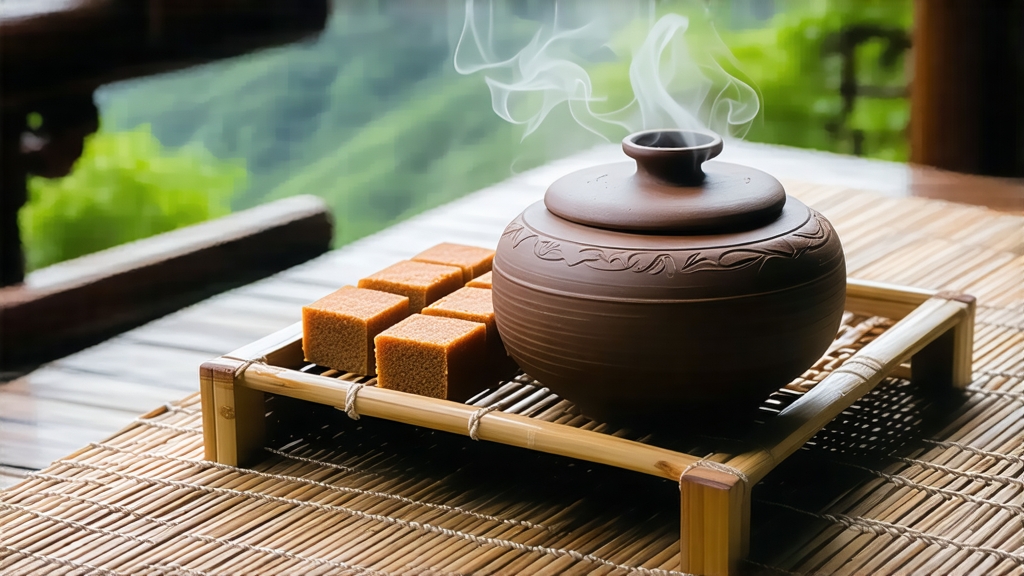
Tucked away in the humid, karst-pocked mountains of southern Guangxi province, Liu Bao (literally “Six Forts”) is the quietest celebrity of China’s dark-tea family. While Pu-erh hogs the limelight, Liu Bao has spent four centuries fermenting its own legend—one of coolies and caravans, of river barges drifting down the Xun Jiang to the Pearl River Delta, and of tea that tastes like petrichor, betel nut and old library. To understand Liu Bao is to taste the slow dialogue between microbes, minerals and time.
-
From Ming Militia to Market Tea
The name Liu Bao refers to the six defensive forts built during the Ming dynasty around the small county of Cangwu. By the late 1500s, soldiers stationed there found that the big-leaf tea growing wild in the surrounding hills resisted mold in the subtropical dampness if it was lightly roasted, packed in bamboo baskets and left to sweat on the river docks. When Qing-era merchants discovered that the tea improved after months on slow boats, they began to commission “return-trip tea” that would leave Guangxi greenish and arrive in Guangdong and Hong Kong dark, mellow and unexpectedly sweet. Thus Liu Bao became China’s first intentionally post-fermented export, predating the famous Yunnan shou Pu-erh by nearly three hundred years. -
Leaf, Land and Microclimate
Liu Bao is made almost exclusively from the local cultivar Zhong ye zhong (middle-leaf strain), a genetic cousin of Yunnan’s big-leaf Assamica but adapted to Guangxi’s shorter winters and copper-red lateritic soil. The tea gardens sit between 200–600 m above sea level, shrouded in morning fog that keeps leaf water content high and polyphenols tender. The same fog nurtures a invisible workforce: Eurotium cristatum, the “golden flower” mold that later blooms inside well-stored Liu Bao, imprinting a faint dried-apricot note that connoisseurs prize. -
Crafting the Darkness
Harvest begins in late April, when three leaves and a bud still blush olive-green. After a brief outdoor withering, the leaves are wok-fried at 280 °C for eight minutes—long enough to kill green enzymes but short enough to preserve leaf integrity. The hot leaves are then rolled for 30 minutes on bamboo trays until they exude a grassy perfume. What follows is Liu Bao’s signature step: “wet piling” (wo dui). Workers pile the semi-dry leaves 70 cm deep inside spotless cement troughs, spray them with misty Wuzhou well water, and cover them with jute sacks. Over the next 25–35 days the pile is turned every five days, allowing thermophilic bacteria to push internal temperatures to 60 °C. The leaves darken, soften and develop a scent reminiscent of damp clay and cooked sorghum. Finally the tea is dried in basket-shaped charcoal ovens, giving each leaf a curled, corduroy-like ridge that the locals call “tiger skin stripe.” -
The Living Brick
Unlike Pu-erh bing, Liu Bao is traditionally pressed into 50 kg bamboo baskets lined with wild banana leaf. The baskets are strapped with rattan and left to mature in riverside warehouses where humidity hovers at 80 %. Here the tea continues a slow, aerobic fermentation. After three years the liquor turns chestnut; after ten it glows like burgundy and acquires the prized “betel-nut aroma” (lang xiang), a peppery-camphor note that lingers in the throat like a cool breeze. -
Brewing the Xun Jiang Memory
For gongfu service, pry off 5 g from the basket’s edge—never the core, where compression is too tight— and rinse quickly with 95 °C water to awaken the leaf. Use a squat 120 ml clay teapot that once brewed Liu Bao exclusively; its pores are impregnated with spores that accelerate flavor. Infuse 15 s, 20 s, 25 s, then stretch to minute-long steeps. The first pour smells of rain on hot granite; the third recalls dried longan and nutmeg; by the seventh, a whisper of tobacco appears. If you prefer grandpa style, drop 3 g into a glass tumbler and keep topping up with 90 °C water; the leaf will sink and rise like a slow-motion ballet, offering sweet, copper-toned sips all afternoon